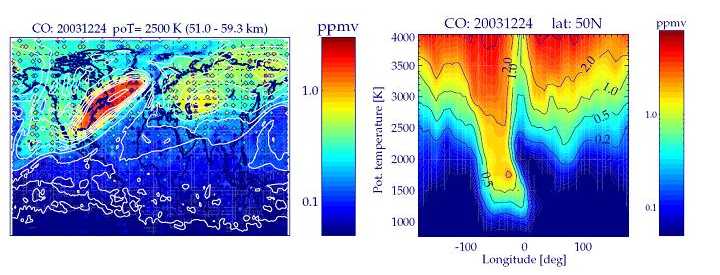MIPAS observes displacement and break-down of the upper stratospheric and mesospheric vortex during a NH major sudden warming
< P>
The figures show the global distribution of CO at the 2500 K potential temperature level (appr. 55 km) and a longitude-altitude cross-section along 50° N for 24 December 2003.
During winter 2003/2004, a strong major warming displaced and finally destroyed the polar vortex in December 2003. The break-down of the vortex was followed by a re-formation with unusually strong subsidence of upper-atmospheric air masses in January/February 2004. CO is a favorable tracer of transport processes up to the mesosphere. MIPAS observations of this tracer provide a detailed picture of the poorly explored upper part of the polar vortex with unprecedented spatial resolution.
CO is built up in the mesosphere from photolysis of CO2 and, thus, is a tracer for mesospheric air masses. The global distribution of CO demonstrates that the vortex (red area) has been displaced from the pole to lower latitudes. During the next days, it will disappear completely, i.e. CO-rich air masses will mix with ambient air.
The longitude-altitude cross-section at 50° N shows that CO-rich mesospheric air masses have subsided down to about 1000K (appr. 32 km) before the sudden major warming.
Reference: http://www.atmos-chem-phys.net/9/2387/2009/acp-9-2387-2009.html

 < P>
< P>